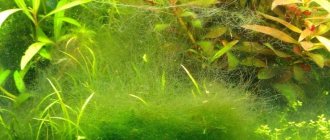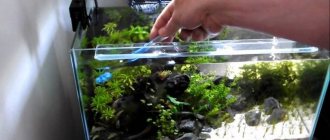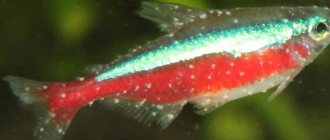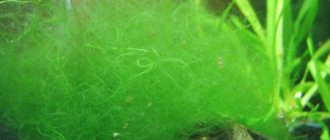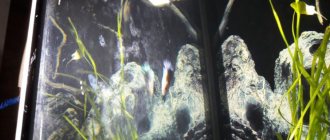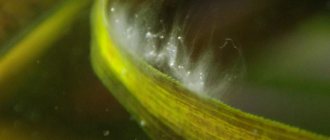Everyone who keeps an aquarium has at least once encountered white worms appearing in it. Most often these are nematodes or, simply put, roundworms that live in any environment, which can be soil and water. An experienced aquarist will immediately say that there is nothing wrong with this, while a beginner will be clearly frightened by the appearance of helminths in an aquarium with pet fish.
For a person, any worms are something unpleasant and creepy, so after discovering them, many are even afraid to put their hands in the water, not to mention fully caring for their fish.
What to do in such a situation? To get started, we recommend reading this article. This article describes in detail methods of controlling parasites. We also recommend that you consult a specialist. Read the article >>>
It is assumed that parasites appear only in advanced cases, when a person does not care about the container and contents. But this is not true, because nematodes in an aquarium can develop at a rapid pace, regardless of what conditions the aquarist has created.
Today, this roundworm is the most common type of helminth and affects humans, animals and plants. Some subspecies of nematodes reach enormous sizes, up to almost 8 meters in length. There are about 20 thousand varieties of this worm, all of them live not only in humans or animals and can be found in fish, crustaceans, wild animals, as well as in plants, such as mushrooms or cereals.
As medical studies have shown, the largest roundworms were seen in whales and reached several meters in length, but most often, nematodes are small parasites a few millimeters long.
If you notice white worms on the walls of your aquarium, do not be alarmed; of course, it is an unpleasant feeling that, in addition to fish, you have some kind of parasites in your aquarium, but you can get rid of them.
The most common helminths that appear in the aquarium
Let's first understand what a parasite is. There are three types of worms that most often settle in an aquarium:
Nematodes
Nematodes are also called microworms, they are indeed the most common throughout the world and are multicellular organisms. Most often they swim freely throughout the aquarium, both independently and thanks to a stream of water from the aquarium filter.
Many people are interested in the question of whether nematodes are dangerous in an aquarium and whether it is possible to destroy the helminth without harming the fish? In fact, you can get rid of them in a short time, while the helminths themselves do not affect the inhabitants of the aquarium in any way, but clearly cause a lot of problems for its owner. Agree, it’s unpleasant to enjoy fish and suddenly notice small white worms swimming past them.
The appearance of white worms is possible immediately after purchasing algae; often it is in the vegetation that a large number of parasites are hidden, which subsequently clog the aquarium.
Hydra
Hydra is a type of white worm that lives in water, and its main feature is the ability to grow even after being split in half. New individuals instantly “come to life” and lead a full-fledged lifestyle. They are also completely safe for fish and other aquarium inhabitants.
Theoretically, an adult hydra can eat eggs and fry, but as practice shows, in reality this happens extremely rarely. As a rule, hydras have enough regular aquarium food, which is quite suitable for them in its nutritional properties.
Planarians
Planarians are also a type of parasite that lives in water. These are very dangerous worms, very different from nematodes. The problem is that they cannot be detected, since they often hide in algae or even in the ground, since adults cannot tolerate daylight hours.
In appearance, planaria has some visual differences from the above-mentioned helminths. In the upper part, the worm's head is much thicker compared to the rest of the body.
If you divide the planaria into several parts, they will all lead a full life, growing back. These parasites eat everything they come across, and the more food they eat, the more actively they multiply. Because of planaria, fish suffer, since the helminth eats fry and eggs, sometimes they can even attack crustaceans.
Guinea worm is a helminth that does not hide from its owner
Uninitiated people are accustomed to thinking that helminths can only be seen in feces, and even then not always. However, there is a parasite that does not hide from its owner, but shows itself to him in all its glory. And it happens like this: the fertilized female migrates into the human skin, where she continues to grow and waits for the maturation of her larvae.
Having waited for the right moment, it literally eats away at the epidermis, causing the appearance of a painful itchy abscess, through which it sticks its tail out.
She needs a person to go into the water, where she can finally be relieved of her burden and release her larvae.
The disease caused by these worms is called dracunculosis. Fortunately, Russians, just as in the case of schistosomiasis, do not risk getting it when swimming in local lakes and rivers, which cannot be said about residents of subtropical and tropical countries in Africa and Asia, especially those where civil wars are raging and the sanitary situation is poor. wish for better. Today, scientists are most concerned about South Sudan, Ghana, Mali and Ethiopia. Cases of infection continue to be recorded there, and so far representatives of the World Health Organization cannot do anything about it.
Getting rid of worms
White worms cause a lot of trouble for aquarium owners. They will appear from an excess of food, poor quality food, with new aquatic plants and decorations. If you don't know what kind of parasite is infested, try raising the water temperature a few degrees and adding table salt. This will not harm the aquarium inhabitants, but will kill ordinary nematodes. If it does not help, then the white worm is a parasite. Methods for getting rid of parasites in an aquarium depend on the type of helminths:
- Planaria should be removed from the aquarium immediately. But this is difficult to do. Aquarium parasites are afraid of light, and therefore are found in the ground and come out only in the dark. Until the owner discovers the parasites, a lot of them can breed. At the same time, they are not afraid of being cut into pieces; they feed on everything that is in the tank. One way to get rid of planaria is to make traps. A piece of meat is wrapped in gauze and placed in the tank at night. The soil should first be siphoned to lift parasites from the bottom. In the morning, the trap is pulled out together with the worms that have pecked at the treat. The method is not very effective; it will not be possible to completely get rid of helminths.
- Worms cannot tolerate fenbendazole. Therefore, drugs containing it are the only salvation if a white worm appears.
- Since turbellaria can appear on the walls of the aquarium, in order to get rid of the white worm, it is necessary to clean the glass and maintain a water temperature of 35 degrees for several hours. Fish and other inhabitants are first removed from the container. After the procedure, the water is cleaned. You can release fish after reaching the optimal temperature for the inhabitants.
- Worms in the aquarium nematodes appear due to an excess of food. This may be the case if the water purification filter is not working well, or you spill a lot of food. You can get rid of the parasite using labyrinthine fish species, such as gourami. If the organic balance of the reservoir is disturbed, the parasites will start again.
- If a hydra appears, the aquarium gets rid of it only by restarting it with a complete replacement of water and decorations. No matter how much you try to reduce the number of parasites by regularly cleaning the tank and removing worms, they will appear again. Get gourami, pond snails or mollies, they feed on hydras.
If the aquarium is not inhabited by plants, remove fish from it and heat the water to 40 degrees. The temperature should be maintained for 2 hours.
Diagnostics
If the body is affected by red worms, the doctor prescribes a stool test, which must be taken several times. But with ascariasis, such a study is not always informative, so other diagnostic methods are often used.
It would also be a good idea to take an X-ray of your lungs. When worms pass through this organ, inflammatory foci appear in it. Worms can also be detected at the initial stage of migration through radiation.
The most effective method for identifying red worms in the body is a blood test. So, if eosinophilia increases or the number of red cells decreases, this will indicate the presence of helminthiasis. Moreover, the higher the concentration, the greater the likelihood of the presence of worms in the body.
To identify hookworm, duodenal intubation is often prescribed, thanks to which the condition of the bile ducts, duodenum, pancreas can be studied and the structure of bile can be determined.
Fish infected with nematodes
Parasitic worms, of which there are more than 6,000 species, infect aquarium fish. This is especially true for exotic species from the tropics. If this happens, one individual will destroy the entire school of fish within a few months. They become infected both from each other and through waste products.
If the infection occurred recently, you can understand the malaise by the lethargy of the fish and the abundant consumption of food. As the parasites develop, the belly swells and the spine may become bent. As a result, the fish will die.
Whatever the species of nematodes, their presence in the aquarium brings discomfort. If you cannot cope with helminths, contact a specialized store. Consultants will help you choose the right remedy to combat helminths.
FAQ
Are free-living nematodes dangerous for humans?
Worms living in an aquarium do not harm humans. This type of nematode is adapted to life only within the aquarium ecosystem.
Is it possible to become infected with parasitic nematodes?
You can become infected by eating contaminated raw fish or by ignoring hygiene rules.
Can purchased fish be immediately placed in an aquarium if it does not show signs of worm infection?
No, this cannot be done, even if the individual looks healthy. First, she is placed in quarantine, and only after making sure that she will not harm other residents is she moved to a permanent place.
Main types
There are free-living roundworms and parasitic nematodes. Let's consider their features.
Regular
The favorite habitats of free-living roundworms are freshwater bodies of water, seas and soil. In such an environment, their density can reach 1 million/cubic meters. m, nematodes take an active part in the functioning of ecosystems.
Free-living roundworms do not pose a danger to living organisms; their lifespan is no more than a few days. They are extremely dependent on the availability of water; fluctuations in moisture concentration are fatal for them. Salty soils are also not suitable for them.
Parasitic
But parasites are extremely resilient. They tolerate any influence of an aggressive environment and unfavorable external factors. A special feature of worms is that during such periods of the life cycle their reproductive function is noticeably enhanced.
In an aquarium, parasitic worms can quickly infect and soon destroy the entire population of fish and vegetation. Nematodes develop in several stages and can have two or more hosts: the larva parasitizes one living creature, the adult worm moves to another. As the parasite develops, it travels from one organ to another, leaving larvae there, thus infecting the entire body. Most of the representatives of the genus parasitize (or exist as commensals) on almost all types of living beings - from protozoa to humans. Nematodes that parasitize plants cause nematode diseases, and living creatures develop nematodes.
Nematode plant diseases affect the root system; invasive diseases pose a danger to living organisms. The most famous parasites of this type found in humans are pinworms, roundworms, and trichinella.
Symptoms
With ascariasis, worms in humans cause a number of characteristic symptoms. At the beginning of the development of the disease, signs similar to ordinary poisoning appear. In this case, the patient experiences various pains, weakness and fatigue, severe irritation and low performance.
When parasites move to the intestines, the following symptoms appear:
- skin rashes;
- prolonged increase in temperature;
- pain in various muscles;
- discomfort in the elbow and knee joints.
During the development of worms, a person feels heaviness in the stomach, pain under the right rib, as well as an enlargement of the liver and nausea that occurs after eating heavy, fatty foods. If roundworms are localized in the lungs, then a person develops a dry cough, chest pain and shortness of breath with increased physical activity. When the worms return to the intestines, the patient develops bulimia or anorexia, vomiting and nausea, and severe abdominal pain.
Parasitism of crooked heads is accompanied by nausea and vomiting, heartburn, diarrhea, headaches and stomach pains. Possible fever, excessive salivation, heart pain, allergic reactions, shortness of breath, itching and cough.
Also, the main symptoms of hookworm infection include belching, dizziness, weakness, increased fatigue, irritability and nervousness. An infected person may also begin to lose hair, and may develop pneumonia, impotence, and infertility.
In some patients, the eyes become inflamed, and in women, the menstrual cycle is disrupted.
It is possible to defeat parasites!
Antiparasitic Complex® - Reliable and safe removal of parasites in 21 days!
- The composition includes only natural ingredients;
- Does not cause side effects;
- Absolutely safe;
- Protects the liver, heart, lungs, stomach, skin from parasites;
- Removes waste products of parasites from the body.
- Effectively destroys most types of helminths in 21 days.
There is now a preferential program for free packaging. Read expert opinion.
Read further:
Algae parasites in the aquarium: examples, description and control methods
Demodex on the face: reasons for its appearance, how to get rid of it, the best ointments
Aquarium fish parasites: worms, algae, name and description
Types of roundworms (nematodes): description and general characteristics of parasites
Mesophiles in animals and plants, reproduction temperature
What do worm larvae look like: round and tapeworms, flukes
Schistosomiasis is an infection of tropical countries
Indeed, these obligate parasites from the genus of trematodes do not live in Russian rivers, ponds and other bodies of water, but with the development of ecotourism and the popularity of tourist destinations in “off-the-beaten-track places,” people are increasingly faced with schistosomiasis, a parasitic infection caused by schistosomes. For their development, they choose the body of snails, from which emerge already formed individuals capable of infecting birds, animals and humans. They penetrate into the body of the latter through the skin, mucous surfaces and as a result of ingesting water from the body of water that he chooses for swimming.
Schistosomes can cause significant harm to health, because these worms have sharp spines, with which they easily pierce the walls of blood and lymphatic vessels, penetrating into a variety of internal organs and tissues. Such an infection can cause liver fibrosis, malignant bladder disease, varicose veins, cysts of various organs, etc.


